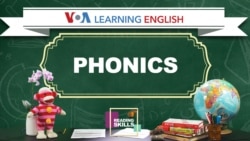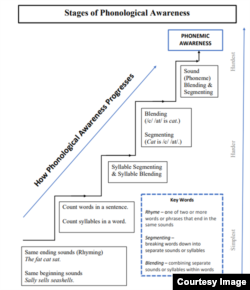Spoken language is made up of sounds. If students want to read, they must be aware of the sound-language connection.
Phonological awareness
The ability to hear sounds in language and work with them is called phonological awareness. Phonological awareness begins with easy skills and moves to more difficult ones. It is important to note that the development of these skills may overlap.
Phonemic awareness
The smallest part of the spoken language is called a phoneme.
A student with phonemic awareness can hear individual sounds and work with them. Phonemic awareness also allows students to understand that the sounds of spoken language work together to make words.
We will talk about phonemic awareness a little later in this article. But for now, know that it is the most advanced type of phonological awareness.
What does phonological awareness look like?
Students with early phonological awareness can:
- find and make rhymes
- count words in a sentence
- count the number of beats (or syllables) in a word
Students with advanced Phonological Awareness can:
- blend small sounds into words
- hear the same first sounds, like toe and tip
- hear the same ending sounds, like sun and bin
- hear the same middle sounds, like bag and tag
Teaching tips for phonological awareness
It is important to know the difference between the name of a letter and the sound of a letter. A letter between two slashes // shows its sound. So, the letter “t” between two slashes represents the sound /t/.
Students should learn each letter by its sound.
At an early stage, say the sound of the letter, not the letter name. This will help students blend words later on. For example, when teaching the letter “n” say /n/ as in “net”, not /en/.
When teaching letter sounds, do not add vowel sounds.
For example, when saying the letter “f,” do not say the sound /ef/. Just say /f/. Adding the /e/ vowel sound at the beginning of the letter makes it harder to blend the sounds in a word later. The most common example is the letter “s.” Simply say /s/. Do not say /es/. Students later may say /e/school, /e/scared, /e/snake –- which would be incorrect.
Teach easier consonants first.
Some languages lack some sounds, such as /f/ and /v/. Don’t teach those to your students first. Some consonants are easier to say. You can stretch them out, saying them for a longer amount of time. They are m, s, f, l, r, n, v, z.
Some consonants end sharply with a puff of air. They are a little harder to say. They are b, c, d, g, p, t, k, and j. Some consonants are simply difficult to say and are less common. Teach them last. They are h, w, y, x, q.
However, some English sounds do not exist in other languages. If students have trouble with some sounds, teach easier ones first.
Teach short vowel sounds first.
Long vowel sounds may be easier to say. But short vowel sounds are in many easy words, such as “mat” and “sun.” However, short vowel sounds can be very confusing. So, first teach them separately – then altogether.
What does phonemic awareness look like?
As we said earlier, phonemic awareness is the most advanced type of phonological awareness.
Students with phonemic awareness can do the following:
Sound isolation
They can hear a single sound in a word and isolate it.
TEACHER: What is the first sound in “bug?”
STUDENT: The first sound in “bug” is /b/.
They can identify and group sounds (or phonemes).
Students can identify sounds that are the same. These sounds may come at the beginning, the middle, or the end of words. Identifying middle sounds is more advanced than identifying beginning or ending sounds.
They can break apart sounds (also called segmenting phonemes.)
Segmenting is the ability to break a word into smaller sounds.
TEACHER: How many sounds in “flag?”
STUDENT: /f/ /l/ /a/ /g/ -- “Flag” has four sounds!
They can blend sounds together (also called blending phonemes).
Blending is the ability to say separate sounds together to make a word.
TEACHER: What word is this -- /b/ /a/ /g/?
STUDENT: Bag!
Blending and segmenting are the most important phonemic awareness skills. These are two phonemic awareness skills most linked to fluency. Both segmenting and blending should be practiced regularly.
They can lose a sound to make new words (also called deletion.)
TEACHER: Pin. If I take away the /p/ sound, what do I have left?
STUDENT: In!
They can add a sound to make new words (also called addition.)
TEACHER: Lap. If I add the /f/ sound to the beginning, what word do I have?
STUDENT: Flap!
They can change a sound to make new words (also called substitution).
TEACHER: If I take away the /s/ in “sat” and add /p/, what word do I have?
STUDENT: Pat!
Teaching tips for phonemic awareness
Use words your students know.
When doing phonemic awareness activities with your class, use words from a story your students are currently reading. It is helpful to use words the students already know.
Focus on sounds not the letters.
The focus of phonemic activities should be on the sounds of words and not on the letters or spelling. However, you can teach phonemic awareness while teaching meaning and pronunciation.
Identify sounds that are different or the same in the home language in comparison to English.
Assessment for Phonological Awareness
Students with poor phonemic awareness skills cannot do the following:
- isolate single sounds in a word;
- break up (or segment) single sounds in a word: paper /pa/-/per/;
- blend sounds into words: /s/ /a/ /t/ = sat;
- add, delete, or substitute sounds.
Here are some questions for assessing phonological awareness.
Count words in a spoken sentence
TEACHER: How many words are in this sentence? "You are my friend.”
STUDENT: Four!
Do They Rhyme?
TEACHER: Do these words rhyme: “bit,” “sit?”
STUDENT: Yes!
TEACHER: Do the words “big” and “bag” rhyme?
STUDENT: No!
Syllable blending
TEACHER: I am going to say a word in parts. Listen: /o/ - /pen/. What word did I say?
STUDENT: Open!
Syllable deletion
TEACHER: Say “sat” without the /at/.
STUDENT: /s/
Syllable substitution
TEACHER: If I take the /s/ away from “sit” and replace it with /p/, what word do I have?
STUDENT: Pit!
Use the tips, strategies, and assessment methods that best serve your learners. Change them to fit your students and your teaching situation.
I’m Anna Matteo. And I’m Caty Weaver.
Anna Matteo wrote this lesson for VOA Learning English. It is part of a larger collection of Early Literacy Materials.
___________________________________________________
Words in This Story
overlap –v. the share or cover part, but not all, of nearby things
phoneme –n. the smallest part of spoken language
syllable –n. a single, unbroken sound of a spoken (or written) word.
blend –v. to mix so that two or more things are combined completely
isolate –v. to set apart and keep alone; apart from other things
segment –v. to divide things into separate parts
deletion –n. the act of removing something or taking something out
___________________________________________________
Resources
University of Toronto’s Balanced Literary Diet;
“Put Reading First – Kindergarten Through Grade 3, The Research Building Blocks for Teaching Children to Read,” U.S. National Institute for Literacy;
“What Does Research Tell Us About Teaching Reading to English Language Learners?” Suzanne Irujo, Reading Rockets;
“Types of Informal Classroom-Based Assessment,” Reading Rockets;









Forum